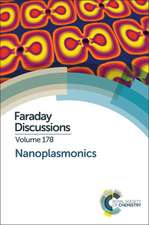EMI/EMC Computational Modeling Handbook: The Springer International Series in Engineering and Computer Science, cartea 630
Autor Bruce R. Archambeault, Omar M. Ramahi, Colin Brenchen Limba Engleză Paperback – 29 oct 2012
This book combines the essential elements of electromagnetic theory, computational techniques, and EMI/EMC engineering as they apply to computational modeling for EMI/EMC applications. It is intended to provide an understanding for those interested in incorporating modeling techniques in their work. A variety of modeling techniques are needed for anyone interested in using computational modeling in the real world. This book includes an introduction of all the popular modeling techniques, such as the Finite-Difference Time-Domain method, the Method of Moments, the Finite Element Method, the Partial Element Equivalent Circuit method and the Transmission Line Matrix method.
EMI/EMC Computational Modeling Handbook, Second Edition will serve many different levels of readers. It will serve as a basic introduction to modeling as applied to EMI/EMC problems for the engineer interested in getting started, and it will help the person already using modeling as a tool to become more effective in using different modeling techniques. It will also be useful for the engineer who is familiar with computational techniques and wishes to apply them to EMI/EMC applications. This book can also be used as a text to help students of electromagnetic theory and application better understand real-world challenges facing engineers.
| Toate formatele și edițiile | Preț | Express |
|---|---|---|
| Paperback (2) | 638.89 lei 43-57 zile | |
| Springer Us – 6 feb 2013 | 638.89 lei 43-57 zile | |
| Springer Us – 29 oct 2012 | 1382.06 lei 43-57 zile | |
| Hardback (1) | 1389.62 lei 43-57 zile | |
| Springer Us – 31 aug 2001 | 1389.62 lei 43-57 zile |
Din seria The Springer International Series in Engineering and Computer Science
- 24%
 Preț: 1041.97 lei
Preț: 1041.97 lei - 20%
 Preț: 643.50 lei
Preț: 643.50 lei - 18%
 Preț: 1225.62 lei
Preț: 1225.62 lei - 18%
 Preț: 965.02 lei
Preț: 965.02 lei - 20%
 Preț: 646.12 lei
Preț: 646.12 lei - 18%
 Preț: 948.79 lei
Preț: 948.79 lei - 20%
 Preț: 646.62 lei
Preț: 646.62 lei - 15%
 Preț: 637.46 lei
Preț: 637.46 lei - 20%
 Preț: 643.83 lei
Preț: 643.83 lei - 18%
 Preț: 949.23 lei
Preț: 949.23 lei - 20%
 Preț: 644.48 lei
Preț: 644.48 lei - 20%
 Preț: 994.92 lei
Preț: 994.92 lei - 20%
 Preț: 645.97 lei
Preț: 645.97 lei - 18%
 Preț: 946.87 lei
Preț: 946.87 lei - 20%
 Preț: 995.57 lei
Preț: 995.57 lei - 18%
 Preț: 956.99 lei
Preț: 956.99 lei - 20%
 Preț: 644.98 lei
Preț: 644.98 lei - 15%
 Preț: 649.54 lei
Preț: 649.54 lei - 18%
 Preț: 950.21 lei
Preț: 950.21 lei - 18%
 Preț: 1221.38 lei
Preț: 1221.38 lei - 18%
 Preț: 957.62 lei
Preț: 957.62 lei - 15%
 Preț: 643.99 lei
Preț: 643.99 lei - 18%
 Preț: 948.47 lei
Preț: 948.47 lei - 18%
 Preț: 947.35 lei
Preț: 947.35 lei - 20%
 Preț: 1284.65 lei
Preț: 1284.65 lei - 20%
 Preț: 1633.95 lei
Preț: 1633.95 lei - 20%
 Preț: 1285.78 lei
Preț: 1285.78 lei
Preț: 1382.06 lei
Preț vechi: 1685.44 lei
-18% Nou
Puncte Express: 2073
Preț estimativ în valută:
264.46€ • 276.81$ • 220.11£
264.46€ • 276.81$ • 220.11£
Carte tipărită la comandă
Livrare economică 31 martie-14 aprilie
Preluare comenzi: 021 569.72.76
Specificații
ISBN-13: 9781461356134
ISBN-10: 146135613X
Pagini: 336
Ilustrații: XVII, 315 p.
Dimensiuni: 155 x 235 x 18 mm
Greutate: 0.47 kg
Ediția:Softcover reprint of the original 2nd ed. 2001
Editura: Springer Us
Colecția Springer
Seria The Springer International Series in Engineering and Computer Science
Locul publicării:New York, NY, United States
ISBN-10: 146135613X
Pagini: 336
Ilustrații: XVII, 315 p.
Dimensiuni: 155 x 235 x 18 mm
Greutate: 0.47 kg
Ediția:Softcover reprint of the original 2nd ed. 2001
Editura: Springer Us
Colecția Springer
Seria The Springer International Series in Engineering and Computer Science
Locul publicării:New York, NY, United States
Public țintă
ResearchCuprins
1 Introduction.- 1.1 Introduction to EMI/EMC.- 1.2 Why Is EMI/EMC Modeling Important?.- 1.3 State of the Art of EMI/EMC Modeling.- 1.4 Tool Box Approach.- 1.5 Brief Description of EMI Modeling Techniques.- 1.6 Other Uses for Electromagnetic Modeling.- 1.7 Summary.- 2 Electromagnetic Theory and Modeling.- 2.1 Introduction.- 2.2 Time-Varying Maxwell’s Equations.- 2.3 Field Solution using Potentials.- 2.4 Maxwell’s Equations in the Frequency Domain.- 2.5 Electromagnetic Fields in Two-Dimensional Space.- 2.6 Numerical Modeling.- 2.7 Electromagnetic Modeling.- 2.8 Summary.- 3 The Finite-Difference Time Domain Method.- 3.1 Introduction.- 3.2 Two-Dimensional FDTD.- 3.3 Three-Dimensional FDTD.- 3.4 Modeling Primary Radiation Sources.- 3.5 Numerical Dispersion and Anisotropy.- 3.6 Mesh Truncation Techniques.- 3.7 Field Extension.- 3.8 FDTD Simulation Errors.- 4 Method of Moments.- 4.1 Introduction.- 4.2 Linear Operators.- 4.3 Pocklington Integral Equation.- 4.4 Method of Moments Development.- 4.5 Summary.- 5 The Finite Element Method.- 5.1 Introduction.- 5.2 Variational Forms.- 5.3 Construction of Finite Elements.- 5.4 Solving the Two-Dimensional Helmholz Equation.- 5.5 Numerical Considerations.- 5.6 Summary.- 6 Preparation for Modeling.- 6.1 The EMI/EMC Problem.- 6.2 Overview of Modeling Options.- 6.3 Selecting a Computational Technique.- 6.4 Elements of an EMI/EMC Model.- 6.5 Model Goals.- 6.6 How to Approach EMI/EMC Modeling.- 6.7 Summary.- 7 Creating EMI/EMC Models.- 7.1 Introduction.- 7.2 Creating Practical Models.- 7.3 Modeling Electromagnetic Radiators.- 7.4 Modeling a Shield with Apertures.- 7.5 Summary.- 8 Special Topics in EMI/EMC Modeling.- 8.1 Introduction.- 8.2 Multistage Modeling.- 8.3 Designing EMI/EMC Filters.- 8.4 Intermediate Model Results.- 8.5 EMI/EMCTest Sites.- 8.6 Antennas.- 8.7 Summary.- 9 Model Validation.- 9.1 Introduction.- 9.2 Validation of Computational Technique.- 9.3 Validation of Software Code Implementation.- 9.4 Validation Using Measurements.- 9.5 Validation Using Intermediate Results.- 9.6 Summary.- 10 Standard EMI/EMC Problems for Software Evaluation.- 10.1 Introduction.- 10.2 General Principles.- 10.3 Generalized Modeling Problems.- 10.4 Standard Problems.- 10.5 Summary.- 11 Advanced Modeling Techniques.- 11.1 Introduction.- 11.2 PEEC Model for PC Board Analysis.- 11.3 The Transmission Line Method.- 11.4 Summary.






















